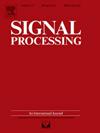一种基于误差信号功率的变步长快速块最小均方算法的水下主动电磁探测系统自适应直接信号干扰消除方法
IF 3.4
2区 工程技术
Q2 ENGINEERING, ELECTRICAL & ELECTRONIC
引用次数: 0
摘要
水下主动电磁探测系统作为一种很有前途的水下目标探测方法,在海洋探测领域受到越来越多的关注。由于发射和接收天线的分离,在运行过程中,接收端直接信号的干扰将是一个很大的挑战,严重影响了系统的目标识别和定位能力。针对水下有源电磁探测系统中的直接信号干扰消除问题,提出了一种基于误差信号功率驱动变步长快速块最小均方(PVSS-FBLMS)算法的直接信号干扰消除方法。与最小均方和归一化最小均方算法相比,该算法很好地符合系统的分块数据传输特性,并且具有较低的复杂度,特别是对于较高的FIR滤波器阶数。考虑到直接信号干扰消除时间有限,该算法在保证算法鲁棒性的同时,引入了基于误差信号功率的变步长调整准则,加快了收敛速度。仿真结果表明,该算法比改进的变步长最小均方(IVSS-LMS)和变步长最小均方(VSS-LMS)算法收敛速度快46.8%左右,而当FIR滤波器阶数为128时,其计算复杂度仅为两种算法的40%左右。在仿真条件下,该算法在低信噪比下的直接信号干扰消除性能明显优于IVSS-LMS和VSS-LMS算法。此外,仿真结果表明,该算法在噪声和DSI振幅剧烈变化的情况下仍能保持稳定。并通过现场实验验证了算法的有效性。实验结果表明,该算法的收敛速度明显快于IVSS-LMS和VSS-LMS算法,稳态输出方差约为10−6V2。本文章由计算机程序翻译,如有差异,请以英文原文为准。

A novel adaptive direct signal interference cancellation method for underwater active electromagnetic detection systems using an error signal power-based variable step-size Fast Block Least Mean Square algorithm
As a promising candidate to detect the underwater targets, the underwater active electromagnetic detection system has gained more attention in the field of marine exploration. Because of the separation of the transmitting and receiving antennas, the direct signal interference in the receiving end would be a great challenge during the operation, which severely deteriorates the system’s capability of target identification and localization. This paper proposes a novel direct signal interference cancellation method based on an error signal power-driven variable step-size fast block Least Mean Square (PVSS-FBLMS) algorithm to address the direct signal interference cancellation issue in the underwater active EM detection system. The proposed algorithm aligns well with the system’s characteristic of block-wise data transmission and demonstrates lower complexity, especially for higher FIR filter orders, compared to the Least Mean Square and Normalized Least Mean Square algorithms. Considering the limited time available for direct signal interference cancellation, the proposed algorithm introduces a variable step-size adjustment criterion based on the error signal power to accelerate convergence, while ensuring the robustness of the algorithm. The simulation has been conducted, which demonstrates that the proposed algorithm converges approximate 46.8% faster than that of the improved variable step-size least mean square (IVSS-LMS) and variable step-size least mean square (VSS-LMS) algorithms while its computational complexity is only about 40% that of the two algorithms when the FIR filter order is 128. The direct signal interference cancellation performance of the proposed algorithm is significantly better than that of the IVSS-LMS and VSS-LMS algorithms at low DSI-to-noise ratios under the simulation condition. Additionally, the simulation results show that the proposed algorithm performs steadily in a highly abrupt change of the noise and the DSI’s amplitude. Besides, the in-field experiments are conducted to validate the effectiveness of the proposed algorithm. The experimental results show that the convergence rate of the proposed algorithm is notably faster than that of the IVSS-LMS and VSS-LMS algorithms, with a steady-state output variance on the order of .
求助全文
通过发布文献求助,成功后即可免费获取论文全文。
去求助
来源期刊

Signal Processing
工程技术-工程:电子与电气
CiteScore
9.20
自引率
9.10%
发文量
309
审稿时长
41 days
期刊介绍:
Signal Processing incorporates all aspects of the theory and practice of signal processing. It features original research work, tutorial and review articles, and accounts of practical developments. It is intended for a rapid dissemination of knowledge and experience to engineers and scientists working in the research, development or practical application of signal processing.
Subject areas covered by the journal include: Signal Theory; Stochastic Processes; Detection and Estimation; Spectral Analysis; Filtering; Signal Processing Systems; Software Developments; Image Processing; Pattern Recognition; Optical Signal Processing; Digital Signal Processing; Multi-dimensional Signal Processing; Communication Signal Processing; Biomedical Signal Processing; Geophysical and Astrophysical Signal Processing; Earth Resources Signal Processing; Acoustic and Vibration Signal Processing; Data Processing; Remote Sensing; Signal Processing Technology; Radar Signal Processing; Sonar Signal Processing; Industrial Applications; New Applications.
 求助内容:
求助内容: 应助结果提醒方式:
应助结果提醒方式:


